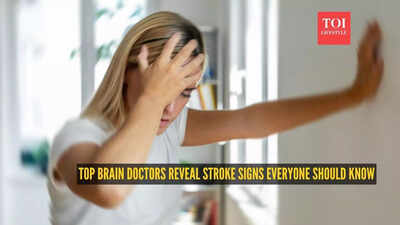A stroke can happen in the blink of an eye, a moment of imbalance, blurred vision, slurred speech and in those minutes the brain is deprived of oxygen, cells begin to die and a lifetime of mobility, speech, independence may hang in the balance. According to neurosurgeon Dr Sunil Kutty of New Era Hospital in Navi Mumbai, the key to survival is recognition and rapid action.In an interview with the Times of India, he shared, “A stroke requires timely management. Hence, quick recognition and action can make all the difference in preventing disability or death from stroke.” What many people do not realise is that strokes are no longer confined to older adults. Young people, too, are increasingly affected, especially when silent risk factors like sleep disorders lurk unnoticed.
Understanding the invisible warning signs
What happens in a stroke? Dr Kutty explained, “A stroke happens when the blood flow to the brain is blocked or a blood vessel bursts, cutting off the oxygen supply. This causes brain cells to die within minutes, leading to life-threatening consequences. Stroke is one of the leading causes of death and long-term disability across the country.”

He emphasised these six signs, summarised by the acronym BE FAST –
- Balance: sudden loss of balance or coordination
- Eyes: blurred or double vision, sudden trouble seeing
- Face: drooping of one side of the face
- Arms: weakness or numbness in one arm
- Speech: slurred or difficulty speaking
- Time: rush to hospital immediately
Early treatment matters. A 2020 study in Neurology found that patients treated within 0-90 minutes of symptom onset had significantly better 3-month outcomes. A 2024 study in Journal of Clinical Medicine claimed, “Early recognition of stroke is therefore critical in reducing treatment delays and improving patient outcomes.”
Young, sedentary and at risk: Sleep apnoea’s hidden role
Often hidden behind the scenes is a serious but under-recognised risk factor of obstructive sleep apnoea (OSA). Dr Amit Kulkarni of Sakra World Hospital in Bengaluru pointed to this as a “silent” contributor to strokes, even in younger patients. He said, “Around 50–70% of people who experience a stroke also suffer from sleep apnoea … OSA is now recognised as one of the major risk factors for recurrent strokes.”A 2005 landmark study in the New England Journal of Medicine found that OSA independently increased the risk of stroke or death (hazard ratio ~1.97) even after adjusting for hypertension and diabetes. More recently, a 2019 review in Sleep Disorders & Stroke noted that OSA should be routinely screened in stroke patients because of its high prevalence and treatment-implications. Kulkarni added, “Even among young adults, OSA is emerging as a key cause of recurrent strokes. If OSA remains untreated in patients who have had a stroke, there is a 50% chance of recurrence within two years.” The takeaway is that snoring, daytime sleepiness, pausing breathing during sleep are not just nuisance symptoms. They could be red flags for a major stroke risk.
Why you must act fast
Time is tissue. In ischemic strokes (blocked arteries), intravenous thrombolysis (clot-busting drugs) must be given within a narrow window, typically up to 4.5 hours after symptom onset. In larger-vessel occlusions, thrombectomy (mechanical clot removal) may be required. A 2020 study in the Critical Care Medicine journal emphasised, “Appropriate treatment of ischemic stroke is essential in the reduction of mortality and morbidity.”

Why Leading Brain Doctors Say Acting Fast on Stroke Symptoms Can Save Your Future
For haemorrhagic strokes (bleeding in the brain), early intervention is equally vital. Delayed action not only increases mortality but also the risk of lifelong disability. Dr Kutty warned, “Every minute counts in stroke management. Remember to recognise the signs of stroke without any delay and initiate timely intervention.”
How to protect yourself and your loved ones
The experts suggested –
- Recognise the signs: Memorise BE FAST — act fast if any of the elements occur.
- Manage your risk factors: Control high blood pressure, diabetes, smoking, obesity, heart disease, sedentary lifestyle aggressively.
- Address sleep health: If you snore heavily, wake up gasping, or feel sleepy by day, ask about a sleep study. “Sleep apnoea often goes undetected and is not routinely evaluated as a stroke risk factor,” said Kulkarni.
- Maintain a brain-healthy lifestyle: Regular exercise, a balanced diet, moderate alcohol, avoiding smoking still matter.
- Get medical help immediately: If any stroke sign appears, even for a moment, call emergency services. It’s not over-caution: it’s life-saving.
Strokes are not just a problem for the elderly. They can strike in youth, quietly. What matters the most is the speed of recognition and treating the hidden risks. Dr Kutty said, “Stroke is a medical emergency. Knowing the BE FAST signs and acting quickly can save lives and prevent lifelong disability.”Dr Kulkarni emphasised, “Obstructive sleep apnoea is a hidden risk — not just for heart disease but for stroke too.” Watch your balance, vision, face, arms, speech and time. If heavy snoring or daytime fatigue is present, speak up as these two silent enemies can sabotage your brain in a single moment. Catch them early. Act quickly. Your future self will thank you.Note: The information provided in this article is for educational purposes only and is not intended as medical advice. Always consult with a healthcare professional before starting any new medication or treatment.







